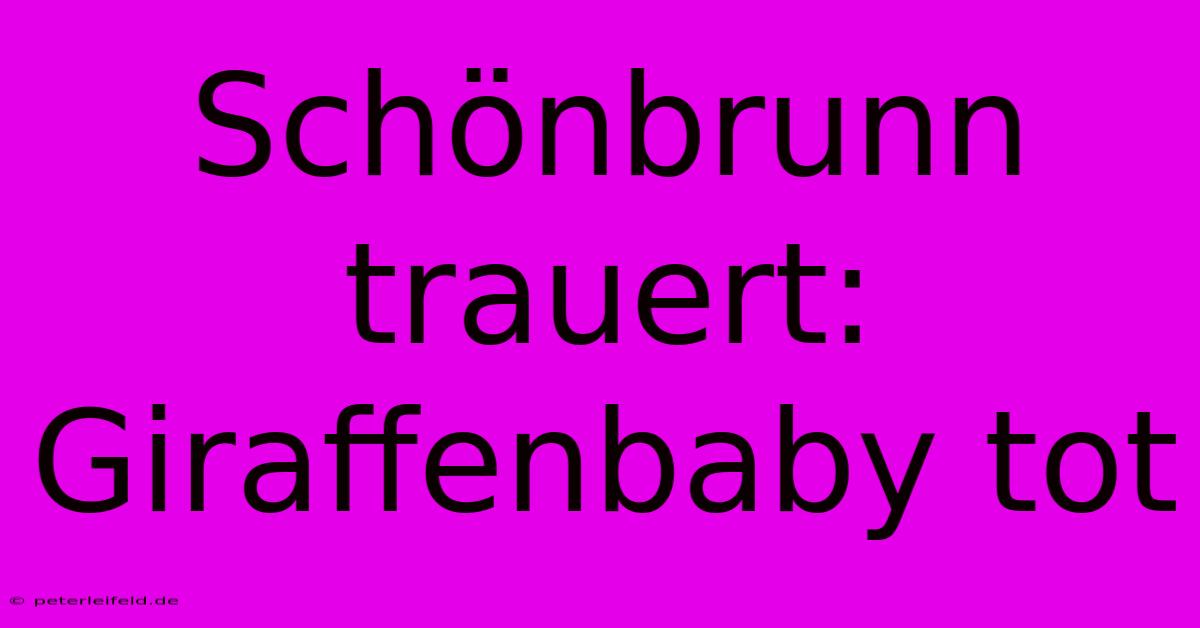Schönbrunn Trauert: Giraffenbaby Tot

Discover more detailed and exciting information on our website. Click the link below to start your adventure: Visit Best Website Schönbrunn Trauert: Giraffenbaby Tot. Don't miss out!
Table of Contents
Schönbrunn trauert: Giraffenbaby tot – Ein herzzerreißender Verlust
Oh man, this one hit me hard. Hearing about the death of the giraffe calf at Schönbrunn Zoo, that really got to me. I mean, I’m not usually one for getting teary-eyed over animal news, but something about this felt…different. It felt personal.
My own clumsy attempts at animal care
I remember this one time, years ago – I was volunteering at a local wildlife sanctuary. I was so eager to help, practically bouncing off the walls. They trusted me with a little orphaned fawn, and I was super careful, right? I thought I was being amazing, all gentle and patient. But, you know, I completely messed up the formula for its milk replacement. The poor little thing got sick, and even though it recovered, I felt like a complete failure. The guilt? Brutal. I learned my lesson: animal care is serious business; proper training is essential.
This wasn't just any giraffe calf; this was a symbol of hope, a tiny ambassador for a species facing challenges in the wild. Losing it felt like a punch to the gut. The zookeepers at Schönbrunn, they poured their hearts and souls into caring for this little one. And for it to end like this... it's devastating.
Understanding Giraffe Calf Mortality
It’s important to understand that giraffe calf mortality, sadly, isn't uncommon, even in the best zoos. There are so many factors involved — things like complications during birth, rejection by the mother, and infectious diseases. Often, these tiny calves are very vulnerable, their immune systems still developing. There's a huge amount of research into improving neonatal giraffe care, focussing on everything from improved nutrition to early disease detection.
What we can learn from Schönbrunn’s loss
Even with the best intentions and the most advanced veterinary care, sometimes things just…happen. It doesn’t mean anyone failed. What's important is that Schönbrunn and other zoos continue to learn from every experience, good or bad. They'll analyze what happened, they'll probably do postmortems, and they'll use this tragic event to refine their practices for future giraffe calves. That's crucial for conservation.
Here’s what we, as the public, can do:
- Support conservation efforts: Donating to organizations dedicated to protecting giraffes in the wild is a powerful way to make a difference. There are lots of great charities out there doing incredible work.
- Educate ourselves: Learning more about giraffes and the threats they face is vital. The more we know, the better we can understand the challenges involved in their conservation.
- Visit zoos responsibly: Zoos are important places for conservation and education. Supporting well-managed zoos that prioritize animal welfare is a way of contributing to their efforts.
Losing the Schönbrunn giraffe calf is heartbreaking. But, hopefully, this loss will serve as a catalyst for greater understanding and improved care for these magnificent animals. It certainly made me think more deeply about how fragile life can be, both in captivity and in the wild. And that, maybe, is a lesson worth learning. We need to continue supporting conservation efforts and ensuring that such tragedies are as few as possible in the future.

Thank you for visiting our website wich cover about Schönbrunn Trauert: Giraffenbaby Tot. We hope the information provided has been useful to you. Feel free to contact us if you have any questions or need further assistance. See you next time and dont miss to bookmark.
Featured Posts
-
Bewaffneter Nach Raub Kufstein
Nov 29, 2024
-
St Gallen Punkt In Conference League
Nov 29, 2024
-
Europa League Highlights Lugano Siegt Erneut
Nov 29, 2024
-
Top Lego Angebote Black Friday 2024
Nov 29, 2024
-
Verstappen Ruhig In Katar Wm Rennen
Nov 29, 2024
